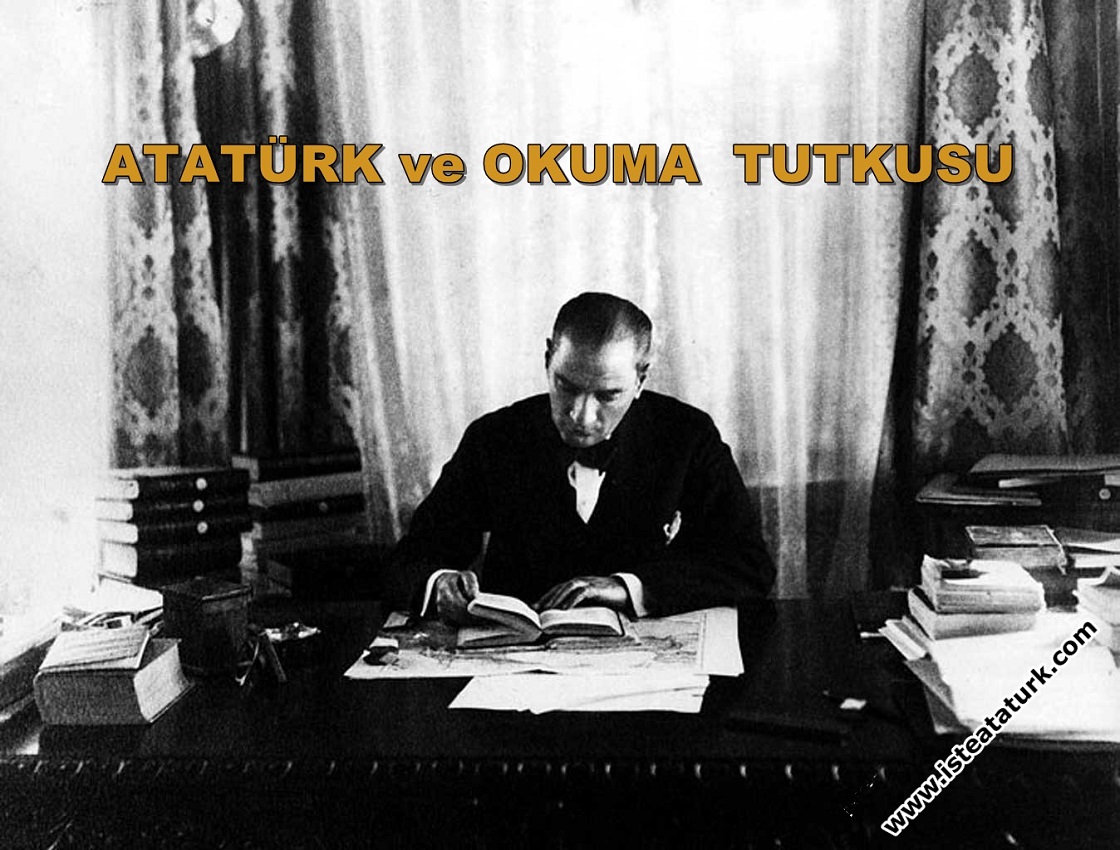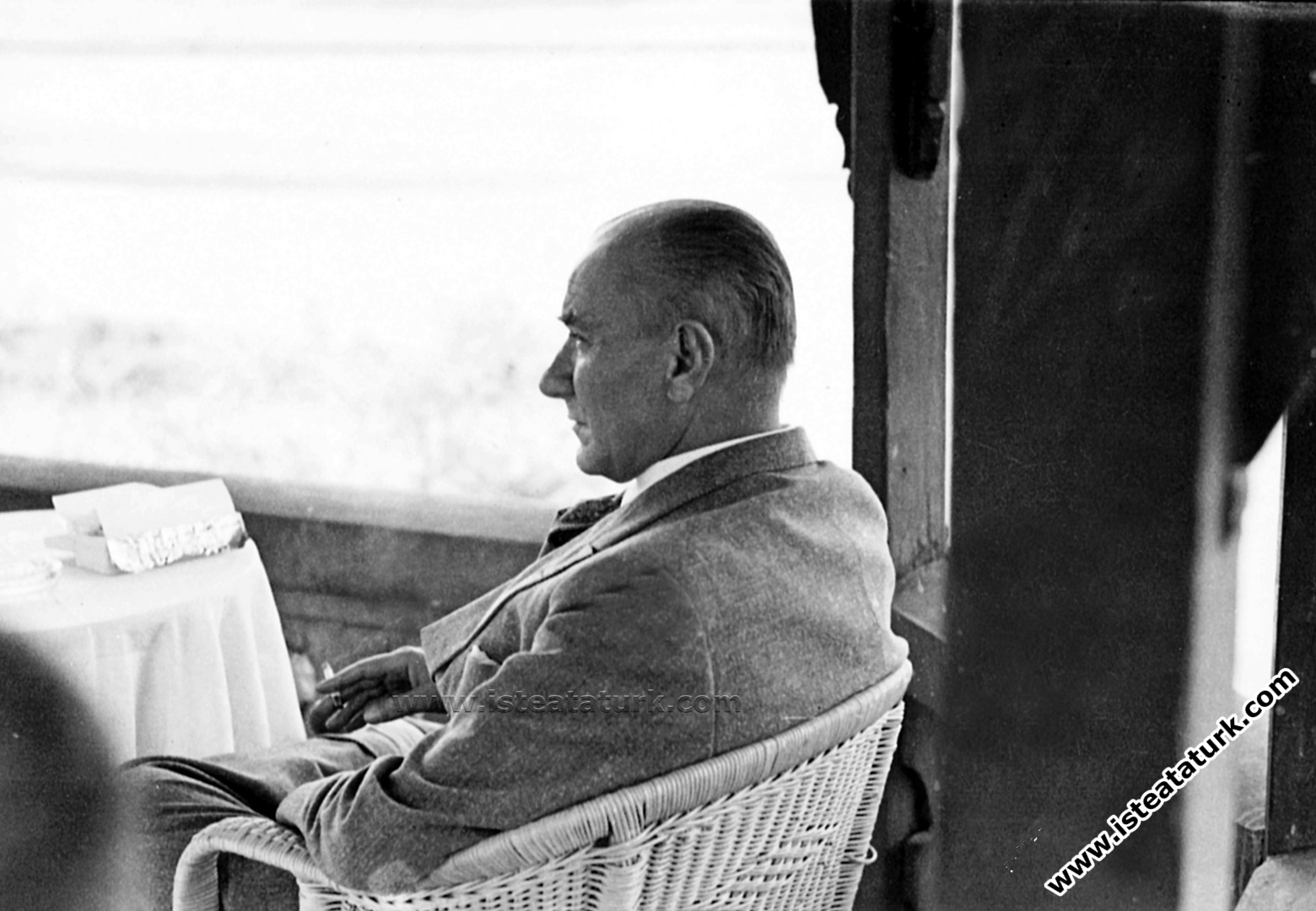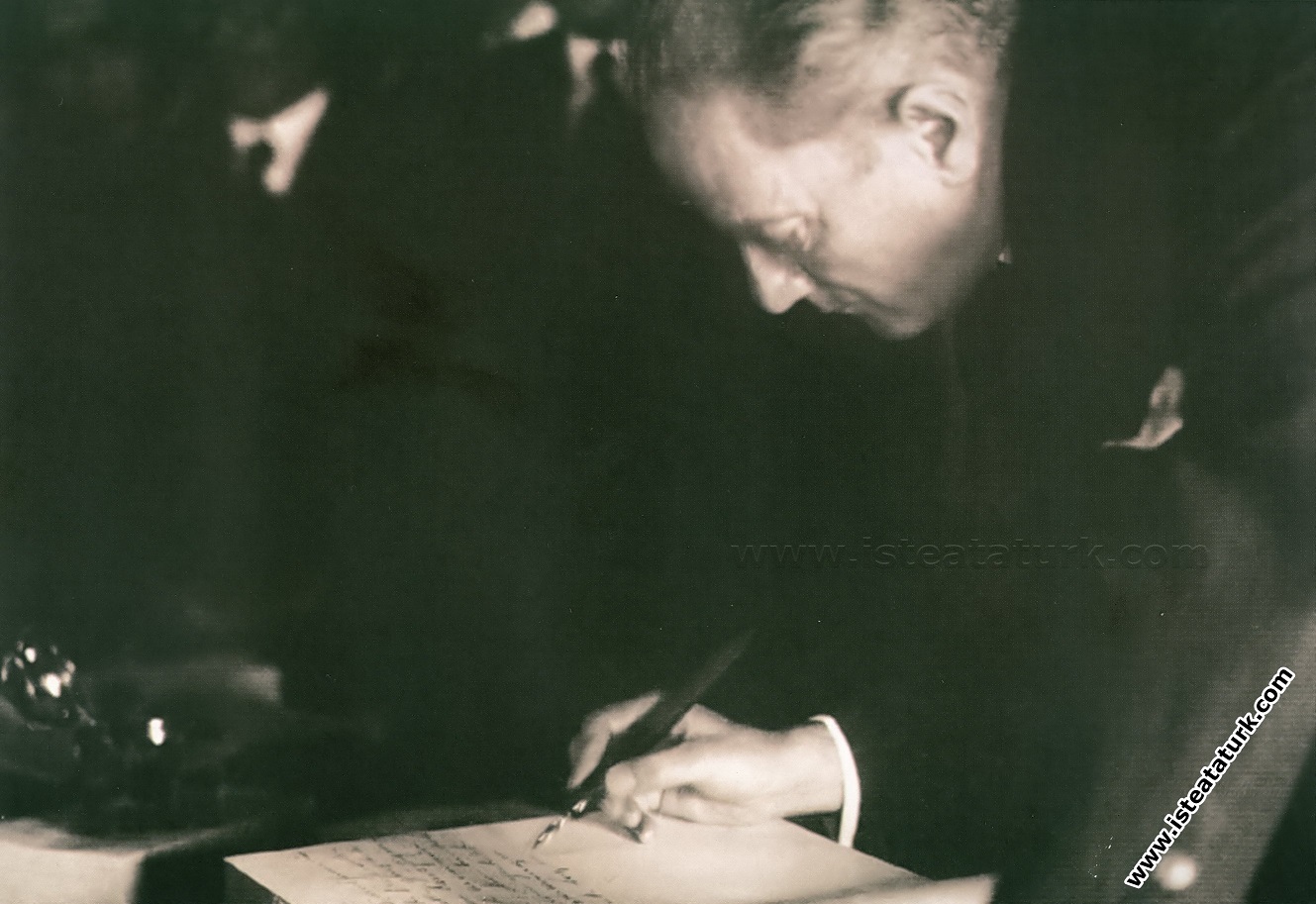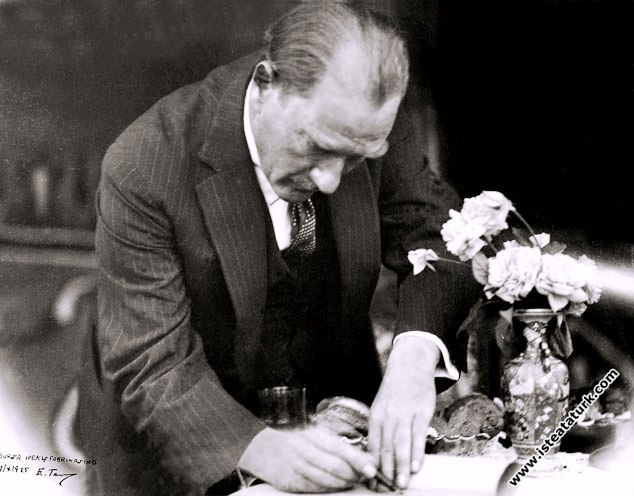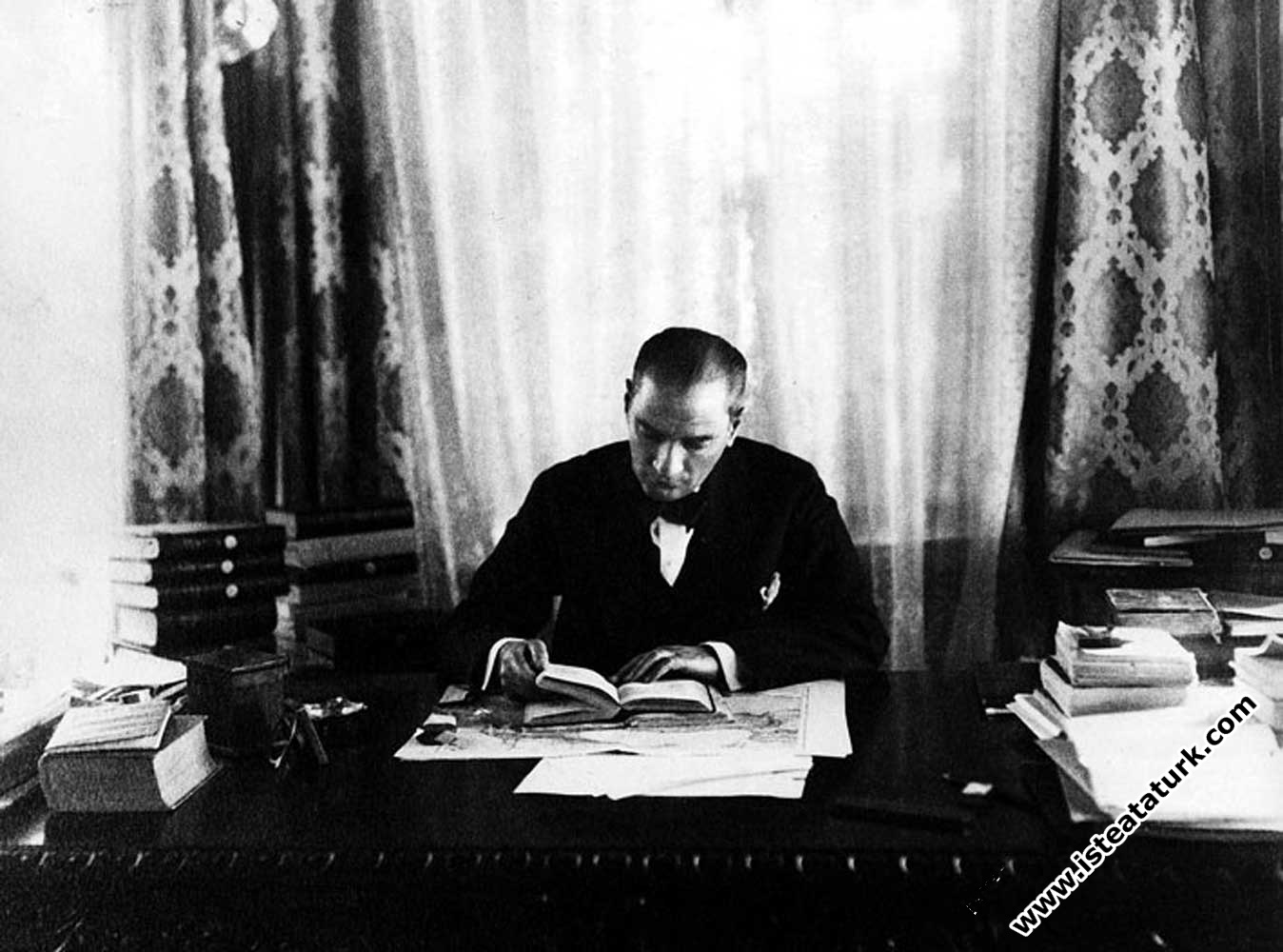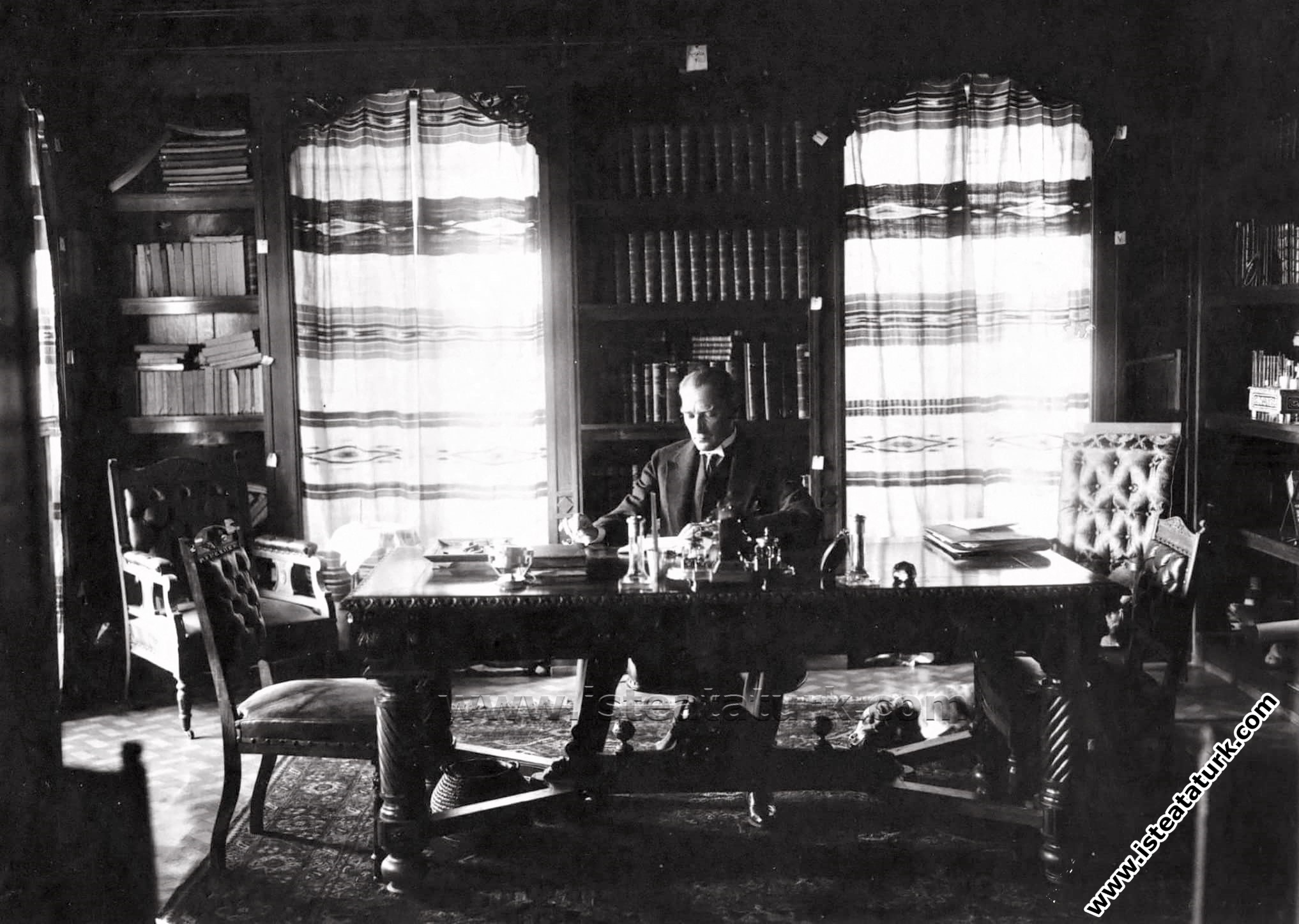
Atatürk's Books and His Library
Character Size
Atatürk's Books and His Library
ATATÜRK'S READ BOOKS AND LIBRARY
We know from the statements and memories of those around him that Atatürk used his spare time by reading. It is understood from the issues he mentioned in his speeches and statements and in the minutes of the Assembly that he examined many scientific publications.
ATATÜRK AND JEAN-JACQUES ROUSSEAU
Especially after he embarked on the War of Independence, Atatürk also focused on doctrines due to his political duties in the Assembly and Presidency. Let's give an example:
The period of the War of Independence... Date i December 1921... Mustafa Kemal is at the podium on the occasion of the bill stating the duties and powers of the Council of Ministers. He will give perhaps the longest speech of his political life. He also has the basis of the Law. At one point in his speech, he extended the book in his hand towards the deputies:
- “Sirs, he says; Sultan Hamid dispersed the deceived deputies based on this book and on the basis of the law mentioned in this book. And he used this nation as his slave for 33 years…”
Mustafa Kemal will now refer to Jean-Jacques Rousseau's “Social Agreement”. Let's watch:
- “... Gentlemen, I examined the principles on which the earliest philosophers who found the constitutional theory worked to establish these theories; I penetrated them.
“... Read Jean-Jacques Rousseau from start to finish. I have read” 1.
Mustafa Kemal also gave one of the brightest examples of oratorship in this speech that exceeded 3 thousand words.
The First Grand National Assembly of Turkey, of which Atatürk was the chairman, is an assembly that is unique in the history of the world parliament and has its own unique features. It has legislative (law-making) and executive (executive) powers. The Parliament elects the government. That's why it's called the "Government of the Grand National Assembly of Turkey". It draws its strength from the nation. He made the principle of "Sovereignty unconditionally belongs to the nation". But there are no parties in this Parliament. Because the nation is gathered around a single purpose: Sovereignty.
The president of this Assembly, which is full of delegates of all kinds of ideas and beliefs, should also know the Ottoman and Turkish history, the history of religion, the history of sociology so that he can channel these discussions in a radical way. For this reason, Mustafa Kemal has read many works on religious and historical subjects. He especially focused on Celâl Nuri's (İleri) Tarih-i Tedenniyat-ı Osmaniye and marked many chapters. (We will explain the meaning of these special signs later).
Many of these books, the lines of which are drawn with colored pencils and the margins of the pages, are on display in the Anıtkabir Museum.
It is stated in Ali Fuat Cebesoy's “My Classmate Atatürk” (page 33) that Mustafa Kemal also secretly read the French Revolution Declaration during his military education in Istanbul.
Since we find it useful to briefly touch on the subject of which our National Hero reads apart from the eternal works, we continue this subject a little more.
Atatürk felt the need to focus more on social and economic issues during the Republican era. Professor Afet Inan says, “Atatürk also showed an interest in sociology and economics and read books”2.
AN UNKNOWN BOOK OF ATATÜRK
Let's also touch on a work of Atatürk known only by a small minority: This book covers the subject of geometry. It's called The Geometry Teachers' Guide. He wrote the book in 1936-37 at Dolmabahçe Palace. This book was published by the Ministry of National Education in 1937 at the State Printing House. The name of the author is not shown in the book.
READ ON TURKISH LANGUAGE AND GRAMMAR:
When it is called full independence, it means full independence, full freedom in all matters, whether political, financial, economic, judicial, moral or infringing. Deprivation of independence in any of these I have enumerated means deprivation of all independence of the nation and country in the true sense (Nutuk, October 1919).
ATATURK
The word “ilh…” in this basic principle of Atatürk, which we have mentioned above, also includes language independence. For Atatürk, just as being deprived of one of these means "deprivation of all independence of the nation and country in the true sense", the language being under the yoke of Arabic, Persian and Western languages is equivalent to the same meaning.
Mustafa Kemal defines independence in another part of his Nutuk as follows:
“The dignity and honor of the Turk, his soul and talent are very high and great. Such a nation should perish rather than live in captivity.”3.
The state of the Turkish language, which was infected with foreign words and did not contain ten percent Turkish, was also a matter of "dignity and dignity" for Atatürk.
The trend of consolidation and simplification, which started with the Young Pens led by Ömer Seyfettin, was short-lived, and Turkish again fell into an eastern sleep on the feather pillows of Servetifünun and Fecriâ-ti.
Turkey, which was the source of exploitation of imperialism and which was reduced to the status of "Sick Man" by the blood vessels of the regimes, abandoned even the word "Turk", which constitutes the name and honor of the country and its descendants, and embraced the Ottoman Empire tightly.
This is the rational reason why Atatürk attached great importance to the concept of "national". For Mustafa Kemal, language should be independent like the homeland. However, Atatürk was not a “linguist who was trained by being educated”. He had to read and deepen on this subject in order to both meet those who were against him scientifically and methodically and to be the leader of this movement. He did so. He read, he read a lot. What did he read? Let's leave the floor to Mr. A. Dilaçar on this issue:
“... One of the first books to confirm the antiquity of the Turkish nation and leave a deep impression on Atatürk is from Necip Asım's Turkish History (1900), from some of the articles published in Türk Yurdu during the Constitutional Period, B. Carra de Vaux's 1911 From the Etruscan Language in Turkey, after Ruşen Eşref's translation from Leon Cahun at Atatürk's command in 1930, The Turanian Origin of the Dialect Preceding Aryan Languages in France and Sadri Maksudi's For Turkish Language in 1931, Leonard, a British archaeologist, Wolley's English original is 1927, and the French translation is Sumerians, which appeared in June 1930.
“... Atatürk's attention was drawn to many works: For example, F. Le-normant: Primitive Language of the Base and Turanian Dialects (1875), H. Winkler: Ural-Altaic Languages and Groupings (1885), AH Sayce: Hittites Or The Story of a Forgotten Community (1888), AC Haddon: Migration of the Nation (1911), AV Edlinger: Ancient Relation of Turkic Languages to Indo-European Languages (1912), F. Hommel: Comparison of 200 Sumerian-Turkish Words (1915) etc.”4 .
DICTIONARY READING
In this section, we try to give as much as we can see about the Turkish language, which is valuable documents for those who will write a detailed biography of Atatürk. We quote the section on this subject from Mr. A. Dilaçar's article, "Atatürk and Turkish", which is a valuable research product:
“... Atatürk attached great importance to dictionaries. Among these, he frequently looked at VV Rad-lov's 4-volume Dictionary of Turkish Dialects (1888-1911) and E. Pekarskiy's 4-volume Yakut Dictionary frequently, and had the words in this dialect examined as essential because of their antiquity. He did not dwell much on the Chuvash. Since one of the things he was very curious about in the field of linguistics was the etymology of foreign words, most of the etymological dictionaries were taken to his table and work desk... I count the main ones of these dictionaries: A. Walde - J. Pokomy's Etymological Dictionary of Indo-European Languages (vol. 3, 1 . bab. 1930-1932), E. Boisaca's Dictionary of Greek Language Etymology (2nd ed. 1923), A. Ernout-A. Meillet's Dictionary of Latin Etymology (1st ed. 1932), O Bloch's Dictionary of French Etymology (1st ed. 1932), and F. Kluge's Dictionary of German Etymology (1st ed. 1934). Among the foreign dictionaries referenced are A. Bailly's Greek-French Dictionary (II. ed. 1925) and L. Quicherat-A. Daveluy's Latin-French Dictionary (55 ed. 1929). Sumerian, Akkadian, Ancient Egyptian, Hebrew, which can be found in the Language Institution Library when necessary; Syriac; Arabic; Persian; Sanskrit; Chinese, Japanese, Finnish, Hungarian etc. dictionaries were also consulted”5.
That's enough. Because a study that will cover all of Atatürk's reading on the Turkish language and the story of his actions in this direction would be a work of great volume.
ATATURK AND LITERATURE WORKS
Which literary works did Atatürk read? It is impossible to detect all of them. We will try to make use of sentences interspersed with anecdotes and memories.
Atatürk's school period is a very barren period as a literary novel. The ones that infiltrated us through the door opened to the West with the Tanzimat are mostly about the form. The essence depends on the past, the subject is at the level of Kan Castle and Ferhatla Şirin. The giant novelist of this period, Ahmet Mithat's Hasan Mellah (1875) and Hüseyin Fellah's are “weak, messy and fairy-tale-like”. To what extent did Uşaklıgil, who is still standing today with his powerful technique and penetrating pen, interested Atatürk? Mustafa Kemal was 9 years old when Halit Ziya Uşaklıgil's first novels Nemide and Bir Dead's Book were published. He was 14 years old in the publication of Ferdi ve Şürekâsı, 17 in Mai ve Siyah, and 20 in Aşk-ı Memnu. When Uşaklıgil's Aşk-ı Memnu was published, Mustafa Kemal passed from the first grade to the second grade at the Military Academy.
We do not think that he read these novels during either the Monastery High School or the Military Academy. In the Manastır Military High School, Mustafa Kemal's world is mathematics and military lessons. His interest in poetry sprouted in this period through Ömer Naci.
A FEW NOVELS IN FRENCH
We come across the first information about the novels read by Atatürk in the interview of Ruşen Eşref (Ünaydın) "Interview with Mustafa Kemal, the Commander of Anafartalar", published in the Çanakkale Extraordinary issue of Yeni Mecmua in 1918. In an interview with Mustafa Kemal at his house in Şişli, Ünaydın describes his study and the books he saw in this room as follows:
“... I watched the room as long as I was alone. On the walls were always pictures of soldiers, the memories of the Balkan War, the Battle of Tripoli, the Movement Army march, and the Mekteb-i Harbiye student. Under the shawl, which was opened in the shape of a butterfly, the Pasha had an enlargement of the Pasha with a heart-shaped and stern look, reminiscent of the young Kazakh officers. On his office, next to a Circassian wedge, stood Balzac's Colonel Shaber (Colonel Charbet), Mopasan (Maupassant's) Bul d Süif (Boule de suif) and Lavedan's Servir. There is no doubt that Pasha fills the emptiness of his quiet moments with literature”6.
ATATÜRK AND ÇALIKUŞU:
Apart from these French novels, Atatürk undoubtedly read the famous novels of our literary history. We know from an anecdote that you read Nur Baba. We learn from Siirt Deputy Mahmut Bey's diary notes that he also read Çalıkuşu. In these notes published in a history magazine, it is said:
“21 August 1922, Akşehir - There is a sensitivity in the enemy. It's as if he sensed that something extraordinary was happening on our side... Let's hope he didn't discover the real target. Pasha has been reading Çalıkuşu for two days. He liked and loved it so much... It's also very relaxing to read something like this on the eve of big moves.
“August 22, 1922 - Today we are in Akşehir. Pasha did not leave the apartment. He read Çalıkuşu until the evening. He was very pleased and appreciated”7.
A POETRY BOOK: TRACES OF CANAKKALE
Mustafa Kemal visits Fikret's Aşiyan on August 19, 1918, with the participation of well-known artists and people of the country8. The newspaper Vakit, dated Tuesday, August 20, 1918, gives the following information about this visit:
“Yesterday before noon, many deceased poets, Tevfik Fikret, visited the deceased's tabernacle in Eyüb.
In the afternoon, many guests went to the poet-i magfurun's Aşiyani on the Rumelihisarı hill. There they were brought to the future by Rıza Tevfik Bey on behalf of his family.
“... Among the visitors, Halide Edip Hanım, Mustafa Kemal Pasha, Dr. Adnan Bey, Sâtı Bey, Süleyman Nazif Bey, Faik Âli Bey, and many other persons belonging to our country's family members...”
Among these visitors is İbrahim Alaeddin Gövsa. The poet writes in his memoirs of that day:
“... (Mustafa Kemal) I don't hesitate when he first asks about the faces he sees there, especially the young people, one by one. One of them came to me:
"Mustafa Kemal Pasha wants to see you," he said.
This connection of the great soldier, whose name and personality I now admire, excited me. I immediately called him and said my name. She held out her beautiful, slender and long-fingered hand, graceful and muscular. He complimented me with a very noble humility, saying that he knew me through my poems about Çanakkale and that he had already wanted to see me:
- Your Excellency Pasha, I said; How is it that you, a commander running from front to front, find time to read the worthless writings of an insignificant young man like me and make them happy?
He gave the following answer:
- I like literature and poetry. I read carefully any work, especially of a military nature. I have read and loved all of your poems about Çanakkale.
“Çanakkale Traces” had not yet been published in a book form at that time, but was published piecemeal in the Tanin newspaper. Since this interest and compliment of the Great Command made me love poems, I collected them all in a small book and published them by dedicating it to the Life Hero of Anafartalar”9.
ATATURK AND FARUK NAFIZ
Prof. Atatürk also read Faruk Nafiz Çamlıbel's poems. Dr. We learn from the memories of Afet Inan. Let's watch:
“... How evident Atatürk's admiration for green would have been when Faruk Nafiz repeated the following piece of poetry:
both green
I used to carry this color in my life corner.
What does a son of man look for in green?
It's green... It's full of wealth, it's full of sky, it's full of hope.
One end is in my eyes, the other is wide.
Spring, sea, countryside, forest are in the color of a tile.
When I say my God looks green to me.
When Mustafa Kemal recited this poem, he was a healthy being, but when he longed for green, he felt that his mortal existence was melting away.
Thus, with this last wish, he wanted to be among the pine trees and greenery”10.
It is known that Atatürk read İsmail Habip Sevük's “The History of Turkish Teceddüt Literature” many times11. He also read many of the contemporary Turkish poets. We heard from his relatives that he read the Servet-i Fünun collection carefully. It was also determined by his relatives that he stated the following opinion with a red pen on one of these volumes:
“The most lyric poet of Servet-i Fünun literature is Hüseyin Siret (Özsever)”.
ATATÜRK'S LIBRARY
What works were in Atatürk's library, how did he benefit from them, what was his reading method?
The only authorized person who can answer all these questions is undoubtedly Professor Dr. Disaster is Inan12. We are also quoting information on this subject from there:
Private libraries are collections of books that individuals are interested in and value. To these can be added the preservation of gifts. Atatürk's library was in his old mansion in Çankaya, in a corner room with a brown and partially glass cabinet. These well-bound books were about military service, law, history, and literature. After 1929-30, the places in this room were not enough with the bringing of a large amount of historical books, especially those published in French, and a second library and work desk made of black-and-white striped oak were added to the adjacent tower room. When the new pink pavilion was to be built, Atatürk wanted from the architect this: A very large library, a spacious place with a table on which maps can be opened and researches can be made, and places to put a large number of books. On the upper floor of today's Presidential Palace in Çankaya, when looking towards Ankara, is the “L” shaped library that forms the right end of the mansion. This place was built in accordance with Atatürk's taste and wishes, and the bookcase with shelves up to the ceiling is separated from the working place by velvet curtains.
Atatürk had transported new books from the old mansion here. Shelves for albums and large magazine collections were made in the section in the hall that entered the library. Some of the other old books were left in the old mansion. In this library of Atatürk, apart from the various publications that were given as gifts, the ones related to history, sociology, economy and especially language, which he had bought himself, constituted the majority.
What I have explained is apparently the state of Atatürk's personal library in the last ten years. It is also possible to examine this from the library registry and draw a conclusion accordingly.
The subject I would like to focus on by mentioning the private library here is "Atatürk and the Book".
For example, according to what I have explained above, this examination is not sufficient only according to the catalog of the books in Atatürk's private library. Because from time to time, Atatürk brought books from other official and private libraries and returned them after reading them.
As far as I know, Atatürk always had an intellectual life. He read for pleasure, read for knowledge, and read for reference to his writings. For example, he listened to the works of our poets in their own voices, as he sometimes had old poems recited at night meetings, and he enjoyed reading beautifully written prose. He himself loved to recite some poems by heart.
Atatürk read the subjects of law in order to examine an issue and to follow the new theories in Western countries. For example, the legal issues of democratic countries have always interested him, and he has read many books on this subject.
Atatürk has read many and various books on the actual history. He had the intellectuals around him translated the new books in foreign languages published in his own time, had their extracts drawn and made controversial speeches on them. In the meantime, he was particularly busy with the history of Islam, and he wanted the services and values of the Turks in Islamic civilization to be known and to be revealed through fundamental investigations.
HOW IT READ AND WORKED
“... Atatürk always read the books at the desk, sometimes he made lines and signs on the book with a red and blue-tipped pen in his hand, and sometimes he took notes on the papers with a pencil. It is rare that he sits at the writing desk in the library of the Yeni Köşk. Rather, he would arrange various books and dictionaries on the long and wide table in the middle, and he would have a watch and a cigarette box next to him. The coffee he drank often could have interrupted his long work. The place of his books at the place where he worked should not have changed.
In addition to these studies, for example, the government focused on the economic issues meticulously, read them, got explanations from the relevant people, and gave their opinions by making signs on the articles.
There is another place where books, dictionaries and brochures are carried almost every night: the dining hall of the mansion. One of the fixtures of the dining room, especially after 1935, is a large electric rotating chalkboard. Books would come from the library, and passages would be read, depending on the nature of the subject discussed at the night meetings.
In short, whatever the subject of the book was, it was a valuable asset for Atatürk's intellectual life. A good and instructive book has always had a great place in Atatürk's life”13.
SPECIAL SIGNS I PUT ON BOOKS
We mentioned that Atatürk put special signs under the sentences that caught his attention in the books he read. Now let's explain the meaning of these signs:
“xx”: Important.
“xxx”: Very important.
“eng.”: Important.
“C. Eng.”: Very important.
“D.”: Attention.
“?”: Does not accept the stated idea, or considers it suspicious.
He underlined the sentences sometimes with a red pen and sometimes with a blue pen. It means that he finds the idea that he draws with a red pen strong and that he does not like the idea he draws with a blue pen.
THE LAST BOOK HE READ
Dear Professor Dr. According to the information given by Afet Inan, the event about the book Atatürk read is as follows:
The date is October 15, 1938... It's Saturday... Atatürk feels good that day. He calls Professor Afet Inan and asks for information about the studies of the Historical Society. After listening to the information presented to him, he wishes to see the "Belleten ", which is being issued by the Historical Society.
Here is the copy numbered 5/6 of Belleten, the last work Atatürk saw and read.
1 Atatürk's Speeches and Statements I, p. 182-214.
2 Afet Inan, Memories and Documents About Ataturk, Ankara 1959, p. 292.
3 Speech, volume I, Turkish Revolution History Institute publication, Istanbul 1981, p. 13
4 Atatürk and Turkish Language, Ankara 1963, p. 45.
5 Atatürk and Turkish Language, Ankara 1963, p. 42.
6 Ruşen Eşref Onaydın, Interview with Anafartalar Commander Mustafa Kemal, Varlık Publications, 3rd edition, p. 17.
7 Hayat History Magazine, issue 7/1966, p. 14.
8 İbrahim Alaeddin Gövsa in his “Pains” incorrectly wrote both the day and the date of this date as 18 August 1917, as a memory mistake.
9 İbrahim Alaeddin Gövsa, Acılar, 1940, p. 8-9.
10 Afet Inan, Memories from Ataturk, 1950, p. 187.
11 İsmail Habip Sevuk, For Atatürk, Republic Press, 1939, p. 84-90.
12 The most authoritative person to answer all these questions is Prof. Dr. Disaster Inan. I would like to emphasize the following fact here: I consider it a pleasure for the Turkish nation that Mr. Afet Inan was with and close to Ataturk. Because we have learned many aspects of our National Hero from his pen and from the very valuable documents he presented to the Turkish nation.
13 Afet Inan, Memories and Documents About Ataturk, Ankara 1959, p. 290-293.
Sadi Borak
Source: ATATÜRK ARAŞTIRMA MERKEZİ DERGİSİ, Sayı 25, Cilt: IX, Kasım 1992
